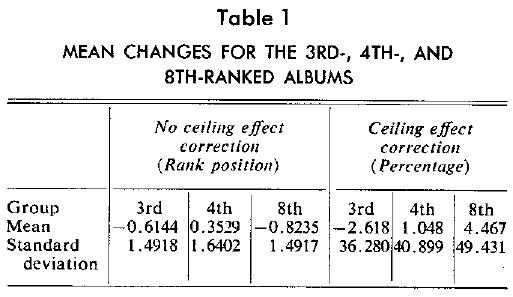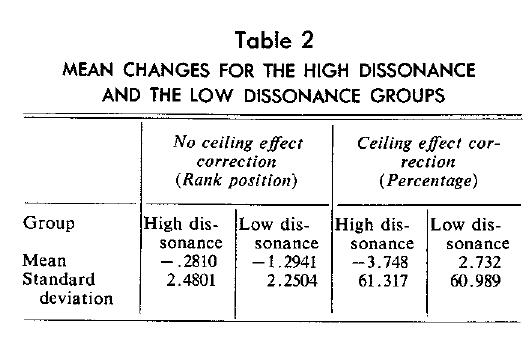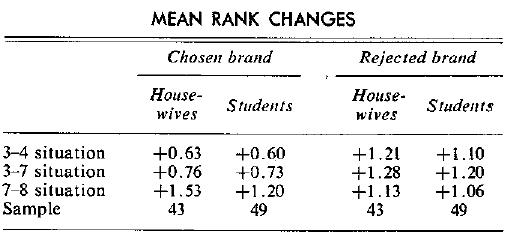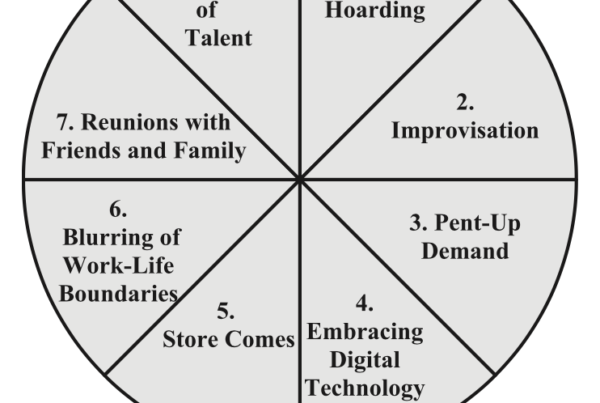Sadaomi Oshikawa*
Introduction
The use of students as subjects for research in consumer behavior has given rise to the question of whether housewives in the marketplace behave like students in classroom experimental situations. One of the challenges to researchers is to specify the conditions under which the findings of classroom experiments can be generalized. In a recent study, Professor Sheth found that housewives and students did not differ in dissonance reduction behavior [9].
Although I agree with Sheth’s conclusion, the similarity he found seems to be the result of an artifact (regression toward the mean) and the reason for the difference in the patterns of reevaluations between the high and low dissonance choice situations is the absence (or the presence) of the ceiling effect.
The ceiling effect works in the following manner the chosen, 7th-ranked item in the high dissonance condition (7—8 choice) has more positions to be reranked upward than the chosen, 3rd-ranked item in the low dissonance condition (3—7 choice). Similarly, the rejected, 4th-ranked item in the high dissonance condition (3—4 choice) has more positions to be reranked downward than the rejected, 7th-ranked item in the low dissonance condition (3—7 choice).
In Sheth’s table [9, p. 244], the predicted reevaluations occurred more frequently in the 3-4 choice condition (66 out of 85, or 77.5%) than in the 7—8 choice (82 out of 119, or 68.8%) and the 3—7 choice (63 out cC 105, or 60.0%) conditions.
When reevaluations are restricted by the ceiling, it is desirable to adjust the changes by convening the rank position changes to percentages of the total possible changes [5]. For example, when the unchosen, 4th- ranked brand was moved to the 5th rank, the change is one out of a possible six places (i.e., 4th to 10th place) or 16.6%. The sign is positive because the change is in the direction predicted by dissonance theory. When the unchosen, 4th brand was reranked to 3rd place, the direction is the opposite of dissonance theory prediction and the percentage change is —33.3%.
Corrected for the ceiling effect, the present experiment replicated the Sheth-type experiments [1, 2, 3, 4, 6, 8, 9] without arousing cognitive dissonance.
Method
Subjects were undergraduate students in the introductory marketing class at the University of Washington. They were asked to rank nine phonograph record albums according to preference on two separate occasions one week apart. 1
On the second occasion, to reduce the possible effect of memory the list of albums was presented in a randomly changed order. Because students were not asked to choose between any of them and were not given the impression that they would receive any of them, no post- choice dissonance could have been aroused.
Results
One hundred fifty-three responses were usable. Rank position changes of the 3rd-, 4th-, and 8th-ranked alb ums from the first to the second survey were measured. Reranking in the direction of the prediction of dissonance theory was given a positive sign, in the opposite direction, a negative sign.
Without adjustment for the ceiling effect, the mean changes in rank position of the initially 3rd-, 4th-, and 8th-ranked albums were —0.6144, 0.3529, and —0.8235, respectively. These changes were statistically significant at the 0.0005, 0.005, and 0.0005 levels, respectively, under the null hypothesis of no change (two- tailed test).
Rerankings of the above three groups of albums differed significantly in the direction predicted by the regression effect hypothesis- The 3rd-ranked albums’ upward movement (predicted by dissonance theory) when chosen was restricted by the ceiling; their reranki ng changes showed downward movement toward the mean rank (5.0). The 8th-ranked albums’ downward movement (predicted by dissonance theory) when rejected was restricted by the floor; they moved upward toward the mean rank. The 4th-ranked albums also moved slightly toward the mean rank. The test of significance for difference among the above group mean changes was not done, because the changes were not independent of each other and thus the analysis of variance is inappropriate.
The rerankings of the 3rd- and 4th-ranked albums simulate the reranking behavior of high dissonance group subjects. Without correcting for the ceiling effect, the mean change was —0.2810 for 3rd- and 4th-ranked albums. Similarly, measuring the rerankings of the 3rd- and 8th-ranked albums, their mean change (—1.2941) was identified as the low dissonance group mean.
The evidence in Table 2 shows that the low dissonance group albums showed a greater degree of converging rerankings (regression toward the mean) than the high dissonance group albums, in the same manner as in the Sheth-type experiment. Again the teat of significance between the two means is inappropriate. The evidence also showed that even when no postchoice dissonance is aroused, the ceiling effect creates the predicted pattern of rerankings, and the initial rank of the albums determines the pattern of subsequent changes.
The reranking data were reanalyzed after they were adjusted for the ceiling effect. Each change in ranking was computed as a percentage of how many positions an album could have moved upward or downward. The mean percentage changes for the initially 3rd-, 4th-, and 8th-ranked albums were —2.62%, 1.05%, and 4.47% respectively (see Table I), none of these was significant under the null hypothesis of no change. Any rerankings were the results of random change. This fact is revealed only if the data are adjusted for the ceiling effect.
The mean of the percentage changes of the 3rd- and 4th-ranked albums was —3.75%; that of the 3rd- and 8th-ranked albums was 2.73% (see Table 2). Neither of these mean changes was significant from no change. This demonstrates that if the data are adjusted, they do not produce a false evidence that the two groups differ in their mode of dissonance reduction.
Conclusion
This experiment demonstrated that the failure to take the ceiling effect into account produces the fallacious conclusion that differing patterns of reranking are caused by different degrees of cognitive dissonance, when the different patterns are in fact caused by the built-in design artifact (regression effect).
The observed similarity in the patterns of rerankings between housewives and students shows that this artifact influenced both housewives and students in the same manner, but it does not necessarily prove that they behaved in the same way psychologically.
References
1. Brehm, Jack W. Postdecision Changes in the Desirability of Alternatives,’ Journal of Abnormal and Social Psychology, 52 (May 1956), 384—9.
2. — and Arthur K. Cohen. “Re-evaluation of Choice Alternatives as a Function of Their Number of Qualitative Similarity, Journal of Abnormal and Social Psychology, 38 (May 1959), 373—8.
3. Greenbaum, Charles W., Alfred Cohn, and Robert M. Kruass. ‘Choice, Negative information, and Attractiveness of Tasks,” Journal of Personality, 33 (March 1965),46—59.
4. Greenwald, Herbert J. Dissonance and Relative Versus Absolute Attractiveness of Decision Alternatives,’ Journal of Personality and Social Psychology, 11 (April 1969), 328—33.
5. Hovland, Carl I., Arthur A. Lumsdaine, and Fred D. Sheffield. Experiments in Mass Communication. Princeton: Princeton University Press, 1949, 284—6.
6. LoSciuto, Leonard and Robert Perloff. Influence of Product Preference on Dissonance Reduction, Journal of Marketing Research, 4 (August 1967), 286—90.
7. Oshikawa, Sadaomi. “The Theory of Cognitive Dissonance and Experimental Research,” Journal of Marketing Research, 5 (November 1968),429—30.
8. Sheth iagdish N. “Cognitive Dissonance, Brand Preference and Product Familiarity,” in John Arndt, ed. Insights into Consumer, Behavior. Boston: Allyn and Bacon,1968, 41—53.
9. — Are There Differences in Dissonance Reduction Behavior Between Students and Housewives ? Journal of Marketing Research. 7 (May 1970), 243—5.
A Reply
Jagdish N. Sheth
I disagree with Professor Oshikawa that the results of my study [2] are due to the built-in design artifact created by the ceiling effect.
First, I think it is inappropriate to include in the denominator only those respondents who changed the ranking of choice alternatives in order to calculate percentages of correct reevaluations in the three choice situations. As pointed out in my earlier study on the interaction of product familiarity, relative preferences for alternatives, and magnitude of dissonance [1]. the choice situation between brands ranked 3rd and 4th is inherently different from that between brands ranked 7th and 8th. The former is between two almost equally preferred and familiar brands, whereas the latter is between the two almost least preferred or unfamiliar brands. There is less tendency to change original rank ordering in the 3—4 choice situation compared to the 7—8 choice situation because the magnitude of dissonance is less in the 3—4 situation. This is indicated to a large extent by the number of responses which did not manifest change in their rank orderings, 99 in the 3—4 choice situation but only 65 in the 74 situation. Thus all responses must be included in the denominator. Accordingly, the percentage of reevaluation in the 3—4 choice situation is, in fact, less (66 of 184, or 36%) than in the 7—8 choice situation (82 of 184, or 44%), and it is about the same as in the 3—7 choice situation (63 of 184. or 34%). These percentages are contrary to the expectation of Oshikawa’s hypothesis of ceiling effect, and so, results of the study cannot be interpreted as caused by the ceiling effect.
Second, if (for the sake of argument) the results of my study were caused by ceiling effect. I should also have obtained negative mean rank changes for the 3rd and the 7th brands as did Oshikawa in his study. Negative signs in front of mean rank changes imply by definit ion results opposite to those predicted by dissonance theory. Hence, Oshikawa’s results are not complementary to the dissonance hypothesis. I have recalculated my data to conform to Professor Oshikawa’s scoring method; they are summarized in the table. Negative mean rank change is contrary to the dissonance hypothesis but mandatory if the ceiling effect is present. My table shows no negative mean rank change. It would appear that the study was therefore not confounded by that artificial effect.
The above table shows that dissonance theory operates with respect to both the chosen and the rejected alternatives, although the magnitude of dissonance varies from one situation to the other. It is not necessary that dissonance be reduced by both of these modes. I am currently finishing a paper, based on five different studies, in which it is suggested that dissonance in a choice situation is reduced either by enhancing the attractiveness of the chosen alternative or by decreasing the attractiveness of the rejected alternative, but not both. Furthermore, the particular mode of dissonance reduction is a function of the preference levels of the choice alternatives involved in the experiment. It the choice is between two equally preferred alternatives (e.g., 3—4), dissonance is reduced by the second mode, whereas if it is between equally disliked alternatives, it is by the first mode. It is possible that what appears to be a ceiling effect may in fact be this differential mode of dissonance reduction.
Finally, I agree with Oshikawa that, in some dissonance studies, the confounding of the ceiling effect may be present. I learned about its existence, by a somewhat painful process, in a study conducted in 1965, some three years prior to the present study. Given my belief that ceiling effect negates rather that, enhances the dissonance effect [1], I consciously attempted to isolate its presence in this study by both proper experimental design (alternatives involved in choice situations have the freedom to move both up and down in reevaluation) and by statistical analysis that does not depend on the concept of mean rank change.
I hope the above comments will help the reader to assess the results of my study. I think it laudable for Oshikawa to show how ceiling effect, if it exists in a dissonance study or any other, can be removed by following the recommendations of Hovland, Lumsdaine, and Sheffield.
References
1. Sheth, Jagdish N. “Cognitive Dissonance, Brand Preference and Product Familiarity,” in Joins Arndt. ed., Insights Into Consumer, Behavior. Boston; Allyn and Bacon 1968, 4 1-33.
2. —. “Are There Differences in Dissonance Reduction Behavior Between Students and Housewives?” Journal of Marketing Research, 7 (May 1970), 243—5.
- This research study is an extension of a previously published experiment. See (7) for details of the experimental de-sign ↩







